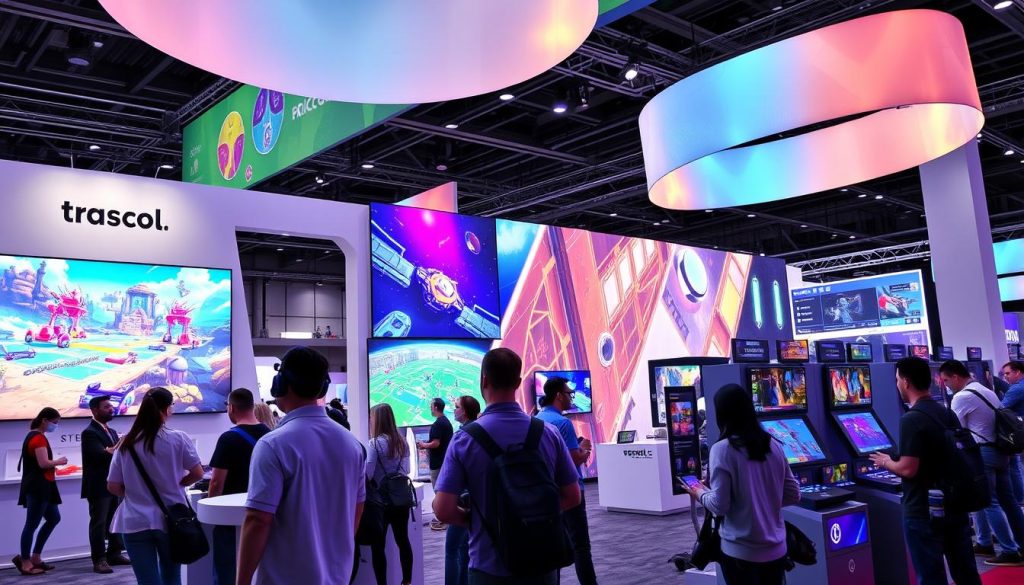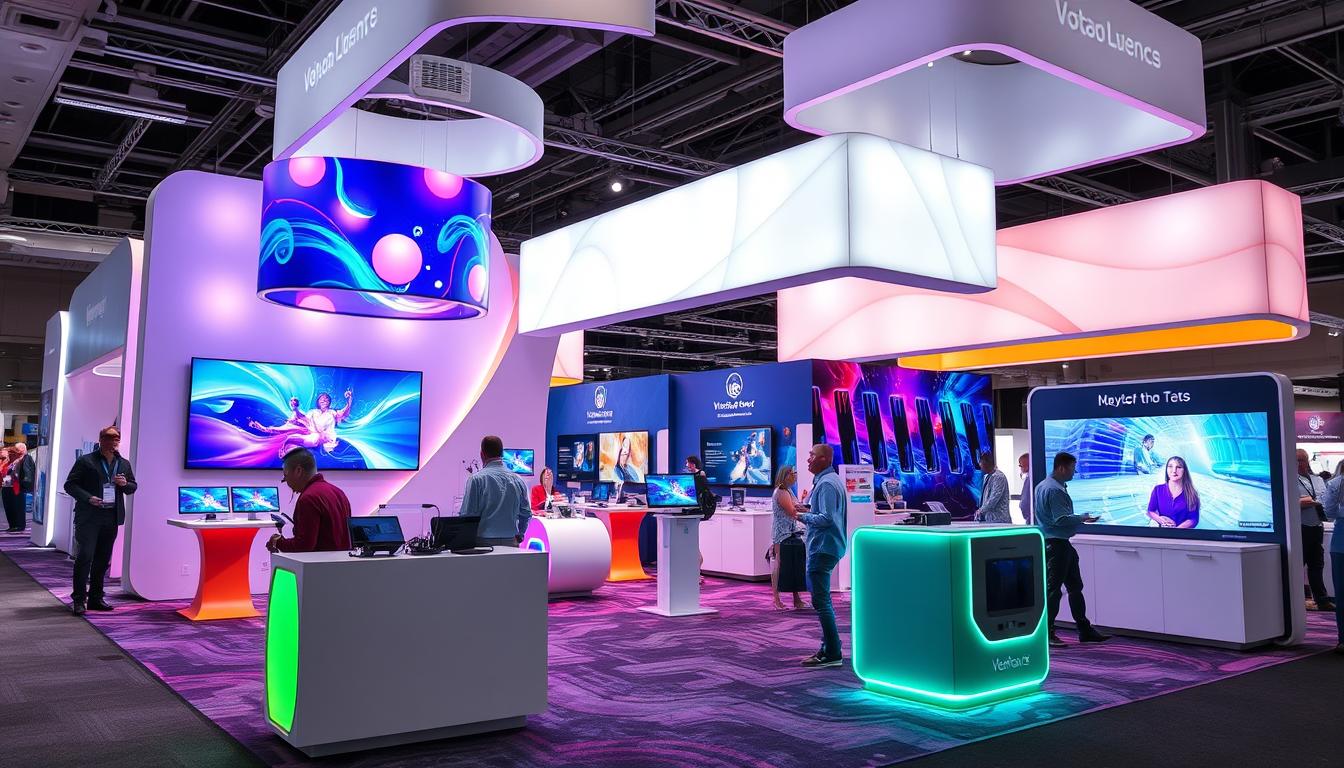Trade shows are evolving, and so are the ways we connect with visitors. The battle between interactive and traditional booths is reshaping event engagement strategies. As companies strive for visitor experience optimization, the choice between these two approaches becomes crucial.
Interactive booths offer exciting, attention-grabbing activations that captivate audiences. They transform passive observers into active participants. Traditional setups, while familiar, may struggle to compete with the allure of interactive experiences.
The key lies in finding the right balance. Some brands thrive with high-tech, gamified booths, while others excel with classic, personal approaches. Understanding your audience and goals is essential for choosing the most effective strategy.
Key Takeaways
- Interactive booths enhance visitor engagement and memory retention
- Traditional setups offer familiarity and personal connections
- Choosing the right approach depends on brand goals and target audience
- Technology integration is crucial for modern event success
- Measuring ROI helps determine the most effective booth strategy
Understanding the Evolution of Trade Show Booths
Trade show booths have undergone a remarkable transformation over the years. From simple stands to immersive experiences, the journey reflects changing business landscapes and visitor expectations. Let’s explore this evolution and how it’s shaped modern experiential marketing.
The Historical Perspective of Traditional Booths
In the past, trade show booths were straightforward affairs. Companies set up tables with product displays and brochures. The focus was on information distribution rather than engagement. These static setups served their purpose but lacked the wow factor modern audiences crave.
The Rise of Interactive Experiences
As competition increased, businesses sought ways to stand out. This led to the rise of interactive experiences. Booths began incorporating touch screens, virtual reality, and hands-on demonstrations. These changes marked the beginning of experiential marketing at trade shows, transforming passive visitors into active participants.
Technology’s Role in Booth Evolution
Event technology trends have played a crucial role in booth evolution. From augmented reality product showcases to AI-powered chatbots, technology has revolutionized how companies engage with attendees. These innovations not only attract more visitors but also provide valuable data insights, helping businesses measure ROI more effectively.
“The future of trade shows lies in creating memorable experiences that blend cutting-edge technology with human interaction.”
As we move forward, the line between physical and digital continues to blur. The most successful booths will be those that leverage the latest event technology trends while maintaining a personal touch. This balance is key to creating lasting impressions in the evolving world of experiential marketing.
Key Components of Traditional Trade Show Booths
Traditional trade show booths have been the cornerstone of industry events for decades. These setups rely on time-tested elements to attract visitors and generate leads. Let’s explore the essential components that make up these classic booth designs.
Display materials form the backbone of traditional booths. Eye-catching banners, posters, and signage communicate brand messages and product information. These visual elements grab attention and draw potential customers in, setting the stage for meaningful interactions.
Product showcases are vital in traditional setups. Physical samples, prototypes, or interactive displays allow visitors to see, touch, and experience offerings firsthand. This tangible approach can be more effective than digital presentations for certain industries.
Promotional literature plays a crucial role in lead generation techniques. Brochures, catalogs, and business cards provide take-home information, extending the booth’s impact beyond the event.
“Traditional booths excel at creating personal connections, but they may struggle to compete with the engagement levels of trade show booth games.”
Staff presence is another key component. Trained representatives engage visitors, answer questions, and nurture leads. Their expertise and interpersonal skills can make or break a booth’s success.
| Component | Purpose | Effectiveness |
|---|---|---|
| Display Materials | Visual Communication | High |
| Product Showcases | Tangible Experiences | Very High |
| Promotional Literature | Information Distribution | Medium |
| Staff Presence | Personal Engagement | High |
While these components have proven effective, they face challenges in today’s digital age. The rise of trade show booth games and interactive experiences has pushed traditional setups to evolve, incorporating new technologies to stay competitive in the ever-changing landscape of industry events.
Interactive Games vs. Traditional Booth Setups: What Works Best?
Trade shows are evolving, and the battle between interactive booth designs and traditional setups is heating up. Let’s dive into the data to see which approach delivers the best results.
ROI Comparison Between Both Approaches
When it comes to return on investment, interactive booth designs often outperform traditional setups. Companies implementing gamification in events report a 20% increase in booth traffic and a 30% boost in lead generation.
| Metric | Traditional Booth | Interactive Booth |
|---|---|---|
| Average Booth Traffic | 100 visitors/day | 120 visitors/day |
| Lead Generation | 20 leads/day | 26 leads/day |
| Cost per Lead | $50 | $42 |
Visitor Engagement Metrics
Interactive booth designs excel in keeping visitors engaged. On average, attendees spend 2.5 times longer at booths featuring gamification elements compared to traditional setups. This increased dwell time translates to more meaningful conversations and brand recall.
Lead Quality Assessment
While traditional booths may generate a steady stream of leads, interactive setups often produce higher-quality prospects. Gamification in events allows for better data collection, helping sales teams prioritize follow-ups. Studies show that leads from interactive booths are 40% more likely to convert into sales within six months.
“Our interactive booth design increased not just the quantity but the quality of our leads. We saw a 35% higher conversion rate compared to previous years.” – Marketing Director, Tech Innovators Inc.
The data suggests that while both approaches have merits, interactive booth designs with gamification elements offer a competitive edge in today’s dynamic trade show landscape.
Gamification Strategies for Modern Trade Show Success
Gamification has revolutionized event engagement strategies at trade shows. By incorporating fun and interactive elements, exhibitors create attention-grabbing activations that captivate attendees. Let’s explore how digital gaming, competitions, and rewards enhance the trade show experience.
Digital Gaming Elements
Trade show booths now feature digital games that blend entertainment with brand messaging. These games range from simple touchscreen quizzes to immersive virtual reality experiences. By integrating digital elements, exhibitors can collect valuable data while providing enjoyable interactions.

Interactive Competitions
Competitions add excitement to the booth experience. Leaderboards display top scorers, encouraging friendly rivalry among visitors. These contests can take various forms:
- Timed challenges
- Trivia contests
- Skill-based games
- Social media photo contests
Reward Systems and Incentives
Effective gamification includes meaningful rewards. Prizes motivate participation and create lasting brand impressions. Consider these incentive options:
| Reward Type | Examples | Benefits |
|---|---|---|
| Physical Prizes | Branded merchandise, product samples | Tangible reminders of the brand |
| Digital Rewards | Discount codes, e-books | Easy distribution, trackable usage |
| Experiential Rewards | VIP access, exclusive demonstrations | Creates memorable brand experiences |
By implementing these gamification strategies, exhibitors can create engaging booth experiences that stand out on the trade show floor. These interactive elements not only attract more visitors but also improve lead quality and brand recall.
Technology Integration in Interactive Booths
The trade show landscape is evolving rapidly, with interactive booth designs leading the charge. Event technology trends are reshaping how brands engage with attendees, creating immersive experiences that leave lasting impressions.
Virtual reality (VR) stands out as a game-changer. Visitors can step into virtual product demonstrations, explore 3D environments, or take part in interactive storytelling. This technology transports attendees beyond the confines of the booth, offering a memorable brand interaction.
Augmented reality (AR) adds digital elements to the real world, enhancing the physical booth space. Attendees can use their smartphones to unlock hidden features, view product information, or play AR games, blending the digital and physical realms seamlessly.
Touchscreens have become a staple in interactive booth designs. From product catalogs to custom quizzes, these interfaces provide a tactile way for visitors to engage with content. Event tracking through these devices allows for real-time data collection, offering valuable insights into visitor behavior.
| Technology | Engagement Level | Data Collection | Cost |
|---|---|---|---|
| Virtual Reality | High | Moderate | High |
| Augmented Reality | High | High | Moderate |
| Touchscreens | Moderate | High | Low |
The integration of these technologies in interactive booth designs not only captivates audiences but also provides valuable data for exhibitors. This shift towards tech-driven experiences marks a new era in trade show marketing, where engagement and analytics go hand in hand.
Measuring Engagement: Interactive vs Traditional Methods
Trade show success hinges on effective engagement measurement. Modern booths leverage advanced techniques for visitor experience optimization and lead generation techniques. Let’s explore how interactive and traditional methods stack up.
Data Collection Techniques
Interactive booths shine in data gathering. They use digital surveys, QR codes, and RFID badges to track visitor movements. Traditional booths rely on manual sign-ups and business card exchanges. Cold email marketing can follow up on leads from both setups, but interactive methods provide richer data.
Analytics and Performance Metrics
Performance tracking differs greatly between booth types:
| Metric | Interactive Booth | Traditional Booth |
|---|---|---|
| Visitor Count | Automatic sensors | Manual clickers |
| Engagement Time | Digital timers | Staff estimates |
| Lead Quality | Behavior analysis | Conversation notes |
| Follow-ups | Automated CRM entries | Manual input |
Real-time Engagement Tracking
Interactive booths excel in real-time tracking. They use heat maps and live dashboards to show hot spots and peak times. This instant feedback allows for on-the-fly adjustments to boost engagement. Traditional booths can’t match this agility, relying on end-of-day reviews.
![]()
While both methods have merits, interactive booths offer superior visitor experience optimization. They provide detailed insights for refining lead generation techniques. Brands looking to maximize trade show ROI should consider upgrading to interactive setups for comprehensive engagement measurement.
Cost Analysis: Traditional vs Interactive Booth Investment
When planning for trade shows, businesses face a crucial decision: traditional or interactive booth setup? This choice impacts not only visitor engagement but also the bottom line. Let’s break down the costs and potential returns of each approach.
Traditional booths often have lower upfront costs. They typically include banners, brochures, and product displays. These setups are familiar and straightforward to implement. On the flip side, interactive booths featuring trade show booth games and experiential marketing elements can have higher initial investments.
Interactive setups might require technology like touchscreens, VR headsets, or custom-built games. While pricier at first, they often lead to higher engagement rates and better lead quality. This can result in a stronger conversion-driven sales funnel, potentially justifying the extra expense.
| Aspect | Traditional Booth | Interactive Booth |
|---|---|---|
| Initial Cost | $5,000 – $15,000 | $15,000 – $50,000+ |
| Staff Required | 2-3 people | 3-5 people |
| Lead Generation (avg.) | 50-100 per day | 100-250 per day |
| Engagement Rate | 20-30% | 40-60% |
| ROI Potential | Moderate | High |
While interactive booths cost more upfront, they often provide better long-term value. They create memorable experiences that can lead to increased brand loyalty and repeat business. This aligns with the growing trend of innovative marketing strategies across industries.
Ultimately, the choice between traditional and interactive setups depends on your budget, target audience, and marketing goals. By carefully weighing these factors, you can make an informed decision that maximizes your trade show investment.
Conclusion
The debate between interactive vs traditional booth setups at trade shows has evolved significantly. Interactive games have emerged as powerful tools for engagement, offering unique experiences that captivate attendees. Yet, traditional booths still hold value for certain industries and audiences.
When considering what works best, businesses must evaluate their specific goals and target market. Interactive booths excel in data collection, real-time engagement tracking, and creating memorable experiences. Traditional setups shine in face-to-face interactions and product demonstrations. The key lies in finding the right balance.
Ultimately, the choice between interactive and traditional booth designs depends on various factors. Companies should assess their budget, industry trends, and desired outcomes. By aligning booth strategy with brand objectives and audience preferences, businesses can maximize their trade show ROI and create lasting impressions on potential clients.






